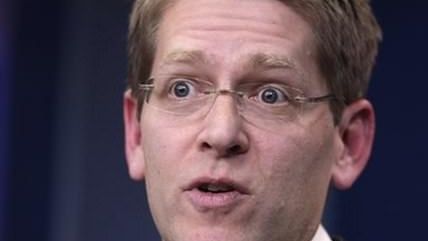White House Press Secretary: The Most Nonessential Job in Government
Do we really need someone who gets paid to dodge 10,000 questions?

Back in January 2011, the Obama administration looked to its new press secretary to "smooth over relations" with reporters.
"With Jay Carney at the podium, Obama hopes to reset press relationship," The Hill reported.
Over three years and 10,000 dodged questions later, it's clear that scheme worked out about as well as the "reset" with Vladimir Putin's Russia. Slate's Dave Weigel asks an excellent question: "What's the point of the job Jay Carney's now leaving?"
The press secretary post is "the oldest continuing staff office in the White House," explains presidential scholar Martha Joynt Kumar, continually occupied since Herbert Hoover appointed the first one, to help him explain his way out of the Great Depression. The point of the job, Kumar suggests, is for the press secretary to serve as an "information conduit … meeting the needs of reporters in order to be an effective spokesperson for the president."
But if the post ever met those needs, it certainly doesn't now. As Weigel puts it, "the most public part of [Carney's] job involved giving non-answers on live TV"; since there's little reason to expect that to change, "let's not replace him." Few reporters would miss the White House press briefing, which has degenerated into a "worthless chore"—especially in an administration as devoted as this one is to choking off information streams it doesn't control.
"This is the most closed, control-freak administration I've ever covered," says David E. Sanger, chief Washington correspondent for The New York Times, whose career spans five presidencies.
The Obama Team's obsession with shaping the message extends to visual media as well. In a New York Times op-ed last December, Santiago Lyon, the Associated Press's photography director, decried "Obama's Orwellian Image Control." Instead of allowing news photographers to take pictures of the president at work, the administration "has systematically tried to bypass the media by releasing a sanitized visual record of his activities through official photographs and videos," taken by government employees.
"If Vladimir Putin were doing something like that, you guys would mock it," NBC's Chuck Todd complained at a press briefing. Actually, "what we have done," retorted the flack on duty, then-deputy press secretary Josh Earnest, "using technology and the president's personal photographer, [is] a way to provide additional insight into what's happening at the White House." (Earnest has been tapped as Carney's replacement, and, with a name like that, who can doubt he'll live up to his predecessor's reputation for sincerity?)
Meanwhile, the Obama team is waging a war on leaks with all the zeal of Nixon's White House plumbers, and far greater competence. The Obama Justice Department has brought a record number of Espionage Act prosecutions against whistleblowers. From 1917 to 2008, that had only been done three times. Under Obama, we're at eight and counting—which sends a message.
"There's no question that sources are looking over their shoulders," says the Associated Press's Michael Oreskes, whose employer's phone records were secretly subpoenaed by the Obama Justice Department in a 2013 leak investigation.
With all of that, is it any wonder that the Obama team's claim to be the "most transparent administration in history" has never risen above the level of laugh-line?
Congressional reformers devoted to transparency and the rule of law should consider tightening up the Espionage Act. And—as long as we're dreaming big—in addition to eliminating Carney's old job, they could set about downsizing the battalion of White House communications functionaries, some 350-strong, devoted to curating the president's Image on the taxpayer's dime.
This column originally appeared in the Washington Examiner.

Show Comments (22)